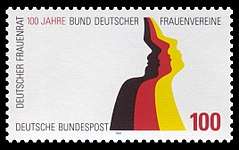Bund Deutscher Frauenvereine
The Bund Deutscher Frauenvereine (Federation of German Women's Associations) (BDF) was founded on 28/29 March 1894 as umbrella organization of the women's civil rights feminist movement and existed until the Nazi seizure of power in 1933.[1]

Its creation was inspired by the founding of the World's Congress of Representative Women meeting on the occasion of the 1893 World's Columbian Exposition in Chicago. Several women from Germany attended this event: Anna Simson, Hanna Bieber-Böhm, Auguste Förster, Käthe Schirmacher. They took the example of the American National Council of Women as a model for the BDF. The International Council of Women also played a role in strengthening the co-operation between the NCW and the BDF.[2]
Governance
| Chairwoman | period of service |
|---|---|
| Auguste Schmidt | 1894-9 |
| Marie Stritt | 1899-1910 |
| Gertrud Bäumer | 1910-1919 |
| Marianne Weber[3] | 1919-1924 |
| Emma Ender | 1924-1931 |
| Agnes von Zahn-Harnack | 1931-1933 |
| Deputy Chairwoman | period of service |
|---|---|
| Anna Schepeler-Lette | 1894-? |
| Anna Simson | ?-? |
| Gertrud Bäumer | 1919-1933 |
The first board was composed of:
- Auguste Schmidt
- Anna Schepeler-Lette, Chairperson of the Latvian Club
- Anna Simson
- Hanna Bieber-Böhm as chairwoman of the association for the protection of minors Representative of the morality movement
- Auguste Förster
- Ottilie Hoffmann, temperance activist
- Helene von Forster, chairwoman of the Nuremberg Association Women's Welfare
- Helene Lange
- Betty Naue
In 1896 they were joined by:
- Jeanette Schwerin, Head of girls and women's groups for social work
- Marie Stritt, Founder of the first legal protection association for women in Germany
Constituent groups
Among others, the Reifensteiner Association was among the members.
History
Wilhelmine period
Weimar period
The Nazi rise to power, in 1933, led to their with the assertion of control over women's associations. Such groups involving communists or socialists were forbidden, and members were arrested or even assassinated in rare cases.[4] All associations were asked to turn in Jewish members, including the Union of Protestant Women, the Association for Home and Countryside, the Union of German Colonial Women, and the Union of Queen Louise.[4] But soon, the majority of the organizations disbanded or chose among themselves to disappear, like the BDF which dissolved in 1933 to avoid being controlled.[5] Some of the affiliated associations joined the Deutsches Frauenwerk.
Membership
Membership steadily grew in the first twenty years:[6]
- 1895 : 65 chapters
- 1901 : 137 chapters and 70,000 members
- 1913 : 2200 chapters and 500,000 members
Articles
- Women in the Third Reich
- Deutsches Frauenwerk
- Frauenschaft
References
- Guido, Diane J. (2010). The German League for the Prevention of Women's Emancipation: Antifeminism in Germany, 1912-1920. New York: Peter Lang Publishing. pp. 1–11. ISBN 9781433107849.
- Adam, Thomas (2005). Germany and the Americas: Culture, Politics, and History : a Multidisciplinary Encyclopedia. ABC-CLIO. ISBN 9781851096282. Retrieved 28 July 2018.
- Dickinson, Edward Ross (2005). "Dominion of the Spirit over the Flesh: Religion, Gender and Sexual Morality in the German Women's Movement before World War I". Gender & History. 17 (2): 378. doi:10.1111/j.0953-5233.2006.00386.x. p. 382.
- http://www.erudit.org/revue/rf/1991/v4/n2/057649ar.pdf
- Marie-Bénédicte Incent, Histoire de la société allemande au XXe siècle. Tome I. Le premier XXe siècle. 1900-1949, Paris, 2011, p. 42
- Sklar, Kathryn Kish; Schüler, Anja; Strasser, Susan (1998). Social Justice Feminists in the United States and Germany: A Dialogue in Documents, 1885-1933. Cornell University Press. ISBN 0801484693. Retrieved 28 July 2018.